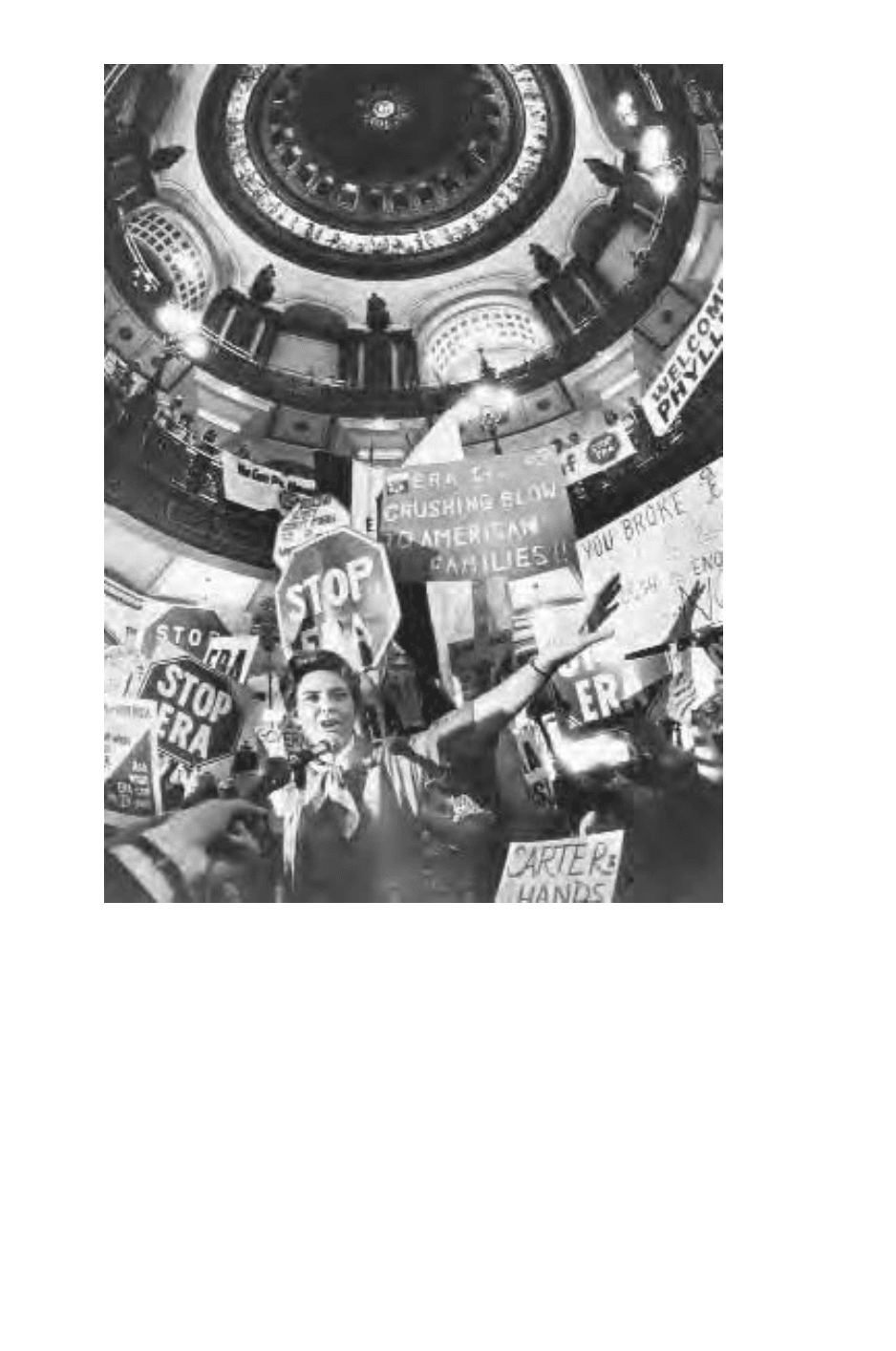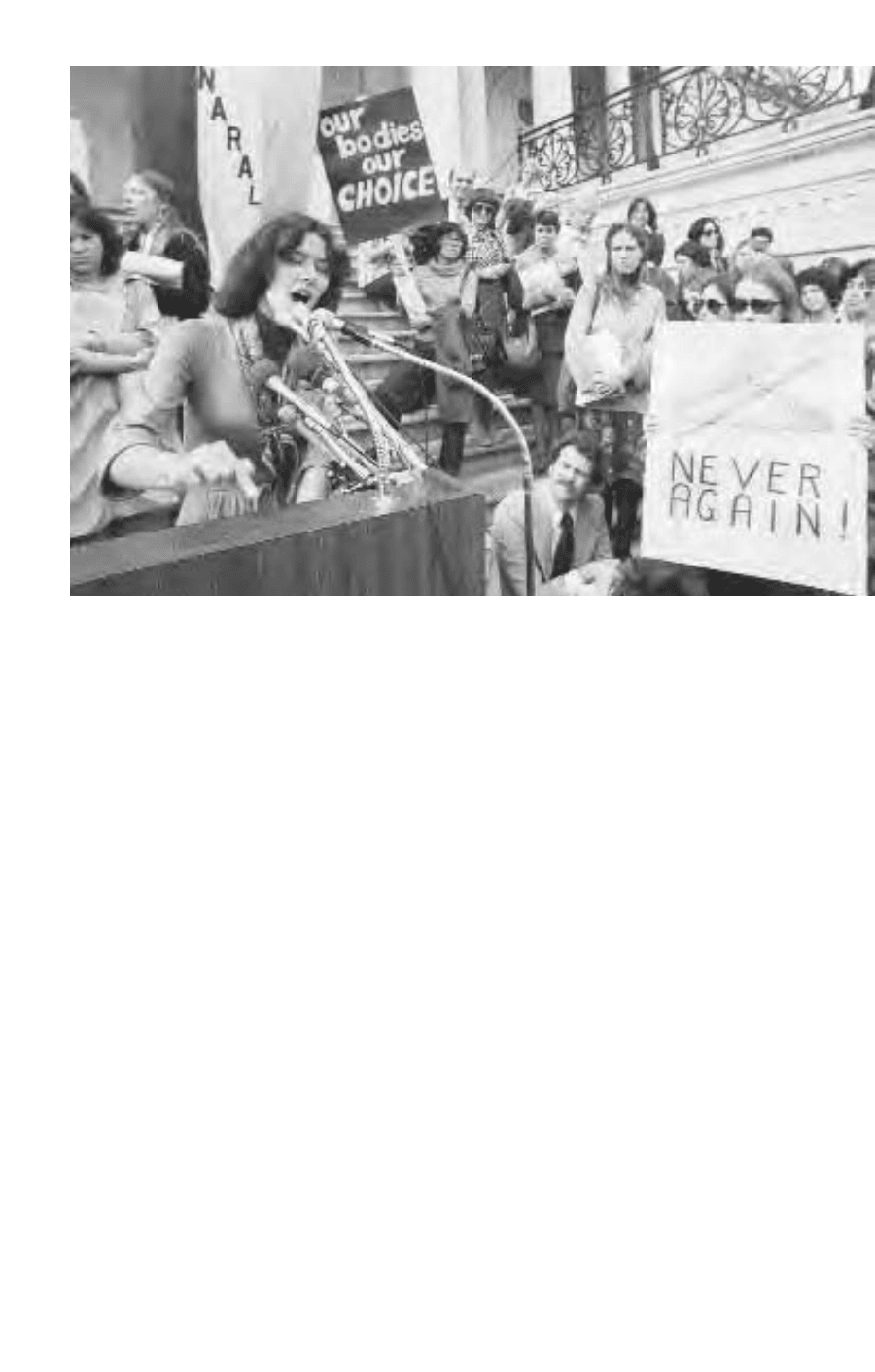Schenken Suzanne O’Dea. From Suffrage to the Senate: An Encyclopedia of American Women in Politics (2 Volumes)
Подождите немного. Документ загружается.


While in prison, Sanger concluded that she needed a different strat-
egy, one based on education, organization, and legislation. In 1921, Sanger
founded the American Birth Control League, in her words, to “build up
public opinion so that women should demand instruction from doctors,
to assemble the findings of scientists, to remove hampering Federal
statutes, to send out field workers into those states where laws did not pre-
vent clinics, to cooperate with similar bodies in studying population prob-
lems, food supplies, and world peace.”
An international personality in the 1920s, Sanger organized the 1927
World Population Conference, held in Geneva, Switzerland, and in 1931,
she organized the National Committee on Federal Legislation for Birth
Control (NCFLBC) to lobby Congress for changes in birth control laws.
NCFLBC developed regional, state, and local organizations with trained
lobbyists, organizers, and fieldworkers. By working with and through lo-
cal women’s clubs, religious denominations, and medical organizations,
these groups intended to pressure Congress and the states to permit physi-
cians to dispense birth control information and devices.
By 1936, Sanger concluded that the legislative route was not going to
be successful and decided to seek the changes she wanted through a court
decision. After fighting a series of court battles, NCFLBC initiated United
States v. One Package of Japanese Pessaries. In the 1936 case, a federal court
concluded that the Comstock law could not stop the importation of di-
aphragms for legitimate medical use and created a distinction between le-
gal and illegal use of contraceptives. The next year, the American Medical
Association resolved that contraception was a valid health practice and
that it should be taught in medical schools. Government agencies began
incorporating birth control services into their programs in 1938.
The Birth Control Clinical Research Bureau, which collected infor-
mation on the reliability of contraceptives, and the American Birth Con-
trol League merged in 1939 to form the Planned Parenthood Federation
of America.
Sanger wrote The Pivot of Civilization (1922), Woman and the New
Race (1923), Happiness in a Marriage (1926), and her autobiographies, My
Fight for Birth Control (1931) and Margaret Sanger: An Autobiography
(1938).
Born in Corning, New York, Margaret Sanger attended Claverack
College, a preparatory school. She completed her nursing training at
White Plains Hospital in 1902.
See also Abortion; Dennett, Mary Coffin Ware; Planned Parenthood Federation
of America; Reproductive Rights
References Kennedy, Birth Control in America: The Career of Margaret Sanger
(1970).
Sanger, Margaret Louise Higgins 599

Schakowsky, Janice D. (b. 1944)
Democrat Jan Schakowsky of Illinois entered the U.S. House of Represen-
tatives on 3 January 1999. Schakowsky believes that Medicare is a “spec-
tacular success” and wants to expand its coverage to all Americans. She
thinks that Social Security is “one of the most successful government ini-
tiatives in our history” and wants to extend its benefits. Her congressional
priorities include federal programs to rebuild public schools and full fund-
ing for Head Start, prenatal care, affordable housing, and environmental
cleanup. Maintaining affirmative action programs, banning employment
discrimination based on sexual orientation, and promoting alternative
sentencing for nonviolent criminals are also among her priorities.
A member of the Illinois House of Representatives from 1991 to
1998, she passed legislation that increased support for day care centers, li-
braries, and Meals on Wheels and that strengthened the Hate Crimes Act.
She also worked for union rights, expanded family leave benefits, and
changes in medical insurance laws that consumer groups sought.
Born in Chicago, Illinois, Schakowsky earned her bachelor of science
degree from the University of Illinois in 1965. A consumer and senior citi-
zens’ advocate, Schakowsky helped lead the successful campaign in the
1970s to require freshness dating on food products. She became executive
director of the Illinois State Council of Senior Citizens in 1985, where she
worked for lower-cost prescription drugs and property tax relief for seniors.
See also Affirmative Action; Child Day Care; Congress, Women in; Lesbian Rights
References “Jan Schakowsky” (1998); www.medill.nwu.edu/people/cook.
Schenk, Lynn (b. 1945)
Democrat Lynn Schenk of California served in the U.S. House of Repre-
sentatives from 3 January 1993 to 3 January 1995. Schenk’s policy interests
included the environment, the line-item veto, and deficit reduction. She
lost her attempt for a second term in 1994.
The daughter of Hungarian Holocaust survivors, Schenk was born in
New York shortly after her parents’ immigration to the United States. She
received her bachelor of arts degree from the University of California in
1967, completed her law degree from the University of San Diego in 1970,
and attended the London School of Economics from 1970 to 1971. Cali-
fornia secretary of business, transportation, and housing from 1980 to
1983, Schenk later served on the San Diego Port Commission from 1990
to 1993. In 1998, she unsuccessfully ran for attorney general of California.
See also Congress, Women in
References Congressional Quarterly, Politics in America 1994 (1993).
600 Schakowsky, Janice D.

Schlafly, Phyllis Stewart (b. 1924)
Conservative leader Phyllis Schlafly founded Stop ERA and Eagle Forum
and emerged as the primary opponent of and most powerful leader
against state and federal Equal Rights Amendments. Schlafly became a na-
tional celebrity in 1964 with the publication of her best-selling book, A
Choice, Not an Echo, in support of Republican Barry Goldwater’s candi-
dacy for his party’s presidential nomination. In it, she argued that eastern
liberal Republicans had conspired to keep the party from choosing con-
servative presidential nominees since 1936, even though the majority of
Republicans had preferred more conservative candidates.
Schlafly entered politics in the 1950s through the Illinois Federation of
Republican Women, ran for Congress in 1952, and served as the federation’s
Schlafly, Phyllis Stewart 601
Phyllis Schlafly
campaigned in
Illinois against
ratification of the
Equal Rights
Amendment; it failed
to gain the necessary
number of states
needed to ratify by
the deadline in 1982
(Corbis/Bettmann)

president from 1960 to 1964. She moved to the national level in 1965
when she became vice president of the National Federation of Republican
Women (NFRW), serving from 1965 to 1967. She ran for the presidency
of the NFRW in 1967 but lost in a divisive contest. After losing, she wrote
to the 500,000 members of the NFRW and asked them to send part of the
dues to a war chest to promote conservative candidates and issues. She es-
tablished the Eagle Forum Trust Fund and began publishing The Phyllis
Schlafly Report in 1967. In 1970, Schlafly again ran for Congress and lost.
After Congress passed the Equal Rights Amendment in 1972, Schlafly
began voicing her objections to it, although she had not objected to it dur-
ing Congress’s consideration of it. The next year, she formed Stop ERA
and began presenting her arguments against the ERA across the nation.
Schlafly’s objections to the amendment included her belief that it would
destroy families, force women into combat, and require unisex public toi-
let facilities. She began an odyssey of testifying before state legislatures,
organizing state lobbying groups, and appearing on national television
shows. Schlafly claimed credit for slowing the ratification and for the fail-
ure of more than twenty-six ratification attempts.
She founded and became president of Eagle Forum in 1975. She or-
ganized a profamily rally at the Houston Astro Arena to protest the Na-
tional Women’s Conference (NWC) in 1977 because she said that the
NWC did not represent her constituency. Schlafly has written several
books, including Who Will Rock the Cradle (1989) and Meddlesome Man-
date: Rethinking Family Leave (1991).
Born in St. Louis, Missouri, Phyllis Schlafly earned her bachelor of
arts degree at Washington University in 1944, her master of arts degree
from Harvard University in 1945, her doctor of laws degree from Niagara
University in 1976, and her juris doctor degree from Washington Univer-
sity in 1978.
See also Eagle Forum; Equal Rights Amendment; National Federation of
Republican Women; National Women’s Conference
References Felsenthal, The Biography of Phyllis Schlafly (1982); Schoenebaum,
ed., Political Profiles: The Nixon/Ford Years (1979).
Schneider, Claudine Cmarada (b. 1947)
Republican Claudine Schneider of Rhode Island served in the U.S. House
of Representatives from 3 January 1981 to 3 January 1991. Schneider en-
tered politics out of her concern for the environment. She founded the
Rhode Island Committee on Energy in 1973, served as executive director
of the Conservation Law Foundation in 1974, and was federal coordina-
tor of the Rhode Island Coastal Management Program in 1978. She was
also a television producer and talk show host.
602 Schneider, Claudine Cmarada

Schneider ran unsuccessfully for the U.S. House in 1978 and then
won her first term in 1980. As a member of Congress, Schneider was in-
strumental in stopping the construction of the Clinch River Nuclear Re-
actor, a project she called “a notorious white elephant,” and was a leader
in the effort to ban dumping sludge and medical waste in the ocean. She
helped pass the Civil Rights Restoration Act of 1988. Schneider left the
House to run for the Senate in 1990 but lost.
Born in Clairton, Pennsylvania, Schneider attended the University of
Barcelona and Rosemont College, receiving her bachelor of arts degree
from Windham College in 1969. She also attended the University of
Rhode Island School of Community Planning.
See also Civil Rights Restoration Act of 1988; Congress, Women in
References Congressional Quarterly, Politics in America: The 98th Congress
(1983); Office of the Historian, U.S. House of Representatives, Women in
Congress, 1917–1990 (1991).
Schroeder, Patricia Nell Scott (b. 1940)
Democrat Patricia Schroeder served in the U.S. House of Representatives
from 3 January 1973 to 3 January 1997. Throughout her congressional ca-
reer, Schroeder fought for equity for women, sought to reduce military
spending, and worked for policies that she believed would benefit fami-
lies. In the summer of 1987, she explored the possibility of a presidential
candidacy but decided against pursuing it.
Schroeder based her 1972 campaign for Congress on her opposition
to the Vietnam War and her support for children and elderly people. Mar-
ried and the mother of two children, Schroeder was asked after her elec-
tion how she could be a mother and a congresswoman. She explained: “I
have a brain and a uterus and they both work.”
When she entered Congress, Schroeder asked to be on the Armed
Forces Committee because of her opposition to the Vietnam War, but
committee chair F. Edward Hébert (D-LA) refused her request, saying that
she had not been in combat. Learning that several committee members
had not been in combat, she pursued the matter and received the com-
mittee assignment. In addition to Schroeder, Hébert had objected to
Ronald Dellums (D-CA) serving on the committee. To demonstrate his
displeasure with their appointments, Hébert provided only one chair for
Schroeder and Dellums in the committee room. They sat on the same
chair until the Congressional Black Caucus pressured the leadership to
convince Hébert to provide a second chair.
Three broad themes characterize Schroeder’s congressional career—
women’s rights, families, and the military—and her legislative proposals
often included some aspect of all three. A leader in the passage of the
Schroeder, Patricia Nell Scott 603

Pregnancy Discrimination Act of 1978, she supported ratification of the
Equal Rights Amendment, advocated federal funding of abortions, and
fought to grant military personnel the right to have abortions in military
hospitals. In 1984, Schroeder began working on the Family and Medical
Leave Act. She held hearings on it, modified it, and in 1993 finally saw it
enacted. The law provides for unpaid leave to care for a newborn, newly
adopted child, or seriously ill child or parent. After President George Bush
vetoed it twice, President Bill Clinton signed it in 1993.
Schroeder advocated improved child support enforcement, en-
hanced services for child abuse victims, and, as cochair of the Congres-
sional Caucus for Women’s Issues, helped develop the Economic Equity
Act. In addition to supporting cuts in the defense budget, she opposed the
MX missile system and led an effort to ban nuclear testing. She worked to
improve family housing and facilities for military service members and
persuaded the Armed Services Committee to permit women to fly com-
bat missions. She helped expose cases of sexual harassment within the
armed services and called on the military to end its discriminatory poli-
cies toward women and gays.
When Anita Hill accused U.S. Supreme Court nominee Clarence
Thomas of sexually harassing her, Schroeder and other congresswomen
sought to have the charges heard before the Senate confirmed Thomas. In
her remarks to the House of Representatives, Schroeder said: “Mr.
Speaker, we are at a very critical time in which a woman has come forward
604 Schroeder, Patricia Nell Scott
Representative
Patricia Schroeder
(D-CO) led a pro-
choice rally on the
Capitol steps against
the Hyde Amend-
ment, which banned
the use of federal
funds for abortion,
1977 (Corbis/
Bettmann)

and made very serious allegations, and there is an attempt to brush them
under the rug in the speed to have an adjournment for the Columbus Day
recess. Columbus, I think, would even be appalled that we could be hur-
rying home to celebrate this great Nation, and also tainting this great Na-
tion’s reputation for justice.” With six other Democratic congresswomen,
her image was captured as they walked up the steps to the Senate to con-
vince the Senate Judiciary Committee to investigate the charges before
voting on Thomas’s nomination.
Schroeder also called for an investigation of another incident of sex-
ual harassment and assault. At the September 1991 national convention of
the Tailhook Association, whose members are Marine and Navy aviators,
more than twenty-five women, some of them naval officers, were sexually
abused and assaulted. When the Navy attempted to minimize the incident,
Schroeder pressed for further inquiries into it. She connected the Tailhook
events with limits imposed upon women in the military and pressed for
policies that would permit women to fly in combat. She noted: “If women
can qualify . . . it would be silly to deny ourselves half the brain power of
this country, just because they have the wrong chromosomes.” Schroeder
retired from Congress in 1997.
Born in Portland, Oregon, Schroeder learned to fly an airplane when
she was fifteen years old and worked her way through college by running
her own flying service. She received her bachelor of arts degree from the
University of Minnesota in 1961 and her law degree from Harvard Uni-
versity in 1964. A field attorney for the National Labor Relations Board
with responsibilities in Colorado, Utah, and Wyoming, she did pro bono
work for Planned Parenthood in Colorado and taught law at the Com-
munity College of Denver and the University of Denver. Schroeder is the
author of Champion of the Great American Family (1989) and 24 Years of
House Work . . . and the Place Is Still a Mess: My Life in Politics (1998).
See also Congress, Women in; Equal Rights Amendment; Family and Medical
Leave Act of 1993; Hill, Anita Faye; Pregnancy Discrimination Act of 1978;
Reproductive Rights; Sexual Harassment
References Boxer, Strangers in the Senate (1994); Doherty, “Surface Racial Har-
mony on Hill Hides Simmering Tensions” (1998); Kaptur, Women of Congress:
A Twentieth Century Odyssey (1996); Schroeder, Champion of the Great
American Family (1989), 24 Years of House Work . . . and the Place Is Still a
Mess: My Life in Politics (1998).
Seastrand, Andrea Ciszek (b. 1941)
Republican Andrea Seastrand of California served in the U.S. House of
Representatives from 3 January 1995 to 3 January 1997. Seastrand worked
to lower taxes for working families, saying: “I oppose higher taxes, period.
Seastrand, Andrea Ciszek 605

Our national budget problems do not exist because we send too little
money to Washington. The problem is that politicians and special interest
groups never run out of ways to spend our money.” Opposed to repro-
ductive rights and gay rights, she worked to stop illegal immigration and
to prohibit welfare payments to minor mothers. She sought to create a na-
tional spaceport agency that would convert defunct military bases into fa-
cilities for commercial space projects.
Born in Chicago, Andrea Seastrand earned her bachelor of arts de-
gree from DePaul University in 1963. A teacher, Seastrand entered politics
when she managed her husband’s state legislative campaigns. After his
death, she won the seat that he had held and served in the California As-
sembly from 1991 to 1995.
See also Abortion; Congress, Women in; Lesbian Rights; State Legislatures,
Women in
References Congressional Quarterly, Politics in America 1996 (1995).
Seneca Falls Convention
In July 1848, Elizabeth Cady Stanton, Lucretia Coffin Mott, and three
other women issued a call for the nation’s first women’s rights convention.
Held in Seneca Falls, New York, on 19 and 20 July 1848 at Wesleyan
Church, the convention attracted about 100 women and men, who dis-
cussed, amended, and adopted a Declaration of Sentiments and Resolu-
tions. Modeled after the American Declaration of Independence, the
Seneca Falls declaration stated in part:
The history of mankind is a history of repeated injuries and
usurpations on the part of man toward woman, having in di-
rect object the establishment of an absolute tyranny over her.
To prove this, let facts be submitted to a candid world.
He has never permitted her to exercise her inalienable right to
the elective franchise.
He has compelled her to submit to laws, in the formation of
which she had no voice.
He has withheld from her rights which are given to the most
ignorant and degraded men—both natives and foreigners.
Having deprived her of this first right of a citizen, the elective
franchise, thereby leaving her without representation in the
halls of legislation, he has oppressed her on all sides.
He has made her, if married, in the eye of the law, civilly dead.
Other grievances listed include divorce laws, property laws, tax laws,
606 Seneca Falls Convention

employment and educational opportunities, and exclusion from the min-
istry. Of the resolutions that the convention considered, the most contro-
versial was proposed by Stanton and called for woman suffrage, and it was
the only resolution that did not pass unanimously. When the discussion
ended, sixty-eight women and thirty-two men signed the declaration. Of
the women who signed the declaration, only Charlotte Woodward lived
long enough to vote after the Nineteenth Amendment was ratified in 1920.
Over the next decade, women’s rights conventions were held in Al-
bany and Rochester, New York; Salem and Worcester, Massachusetts;
Cleveland, Ohio; and other communities. Conventions were not held dur-
ing the Civil War, and afterward, they generally took place under the aus-
pices of a suffrage organization.
References Flexner and Fitzpatrick, Century of Struggle: The Woman’s Rights
Movement in the United States, enlarged edition (1996); Ravitch, ed., The
American Reader (1990).
Separate Spheres
“Separate spheres” was a nineteenth-century phrase that articulated the
belief that men belonged in the public world and women in the private
world. Based on the assumption that men had greater physical strength
and intellectual and mental abilities than women, it was believed that men
were better suited for war, politics, work, the professions, and art. Women,
with their presumed greater morality, nurturing skills, and self-sacrificing
natures, were believed to be created for motherhood, domestic duties, and
marriage.
The concept of separate spheres did not extend to women in slavery.
Fieldwork and heavy labor were more likely their plight than even do-
mestic service. In addition, poor women, including those once married
but widowed and those whose husbands did not support them, did not
have the luxury of confining their lives to domestic activities.
See also Coverture
Sex Discrimination
Discriminating on the basis of sex was the policy in the United States un-
til women began challenging it in the 1840s in the first wave of the
women’s rights movement and continued to challenge it in the second
wave of the movement that began in the 1960s. The areas in which women
were legally discriminated against included education, employment, pay,
jury service, and credit. In addition, women could not vote, hold public
office in many states, or serve in the military, and married women could
not conduct business in their own names, sue, or be sued.
Sex Discrimination 607

In the mid–nineteenth century, states began to pass married women’s
property acts, but until passage of the Nineteenth Amendment in 1920,
little action was taken to remove discriminatory laws against women. In
the 1920s, some states eliminated prohibitions against women holding
public office and serving on juries. Until passage of the Equal Pay Act in
1963, it was legal to pay different rates to women and men performing the
same job, and until passage of the Civil Rights Act of 1964, it was legal to
refuse to hire a woman for a job based on her sex.
The emergence of the feminist movement in the 1960s brought de-
mands for the elimination of other forms of sex discrimination. Title IX
of the Education Amendments of 1972 ended sex discrimination in edu-
cation at institutions that received federal funds, and the Equal Credit Op-
portunity Act of 1974 prohibited discrimination in financing on the basis
of sex or marital status. Also in the 1970s, the U.S. Supreme Court began
to decide that sex discrimination violated the Fourteenth Amendment.
Feminists, however, found that the progress was inadequate and too slow
and began a campaign for passage of the Equal Rights Amendment. Con-
gress passed the amendment, but it failed in 1982 because only thirty-five
out of the necessary thirty-eight states had ratified it.
See also Cable Acts; Civil Rights Act of 1964, Title VII; Education Amendments
of 1972, Title IX; Equal Credit Opportunity Act of 1974; Equal Pay Act of
1963; Equal Rights Amendment; Married Women’s Property Acts; Nineteenth
Amendment; Suffrage
Sexual Harassment
The Equal Employment Opportunity Commission (EEOC) defines sexual
harassment as follows: “Unwelcome sexual advances, requests for sexual
favors, and other verbal or physical conduct of a sexual nature . . . when
submission to or rejection of this conduct explicitly or implicitly affects
an individual’s employment, unreasonably interferes with an individual’s
work performance or creates an intimidating, hostile, or offensive work
environment.”
Harassers can be women or men, and victims can be women or men.
The harasser could be a supervisor, an agent of the employer, a coworker,
or not an employee. The victim does not have to be the person harassed
and could be anyone affected by the offensive conduct. In addition, the
victim does not have to suffer economic injury or be discharged to have a
complaint.
The EEOC has defined two kinds of sexual harassment, quid pro quo
and hostile environment. Quid pro quo harassment is committed when a
person submits to being harassed out of concern for her or his job, potential
promotion, job assignment, or other conditions of work. Only a supervisor
608 Sexual Harassment
